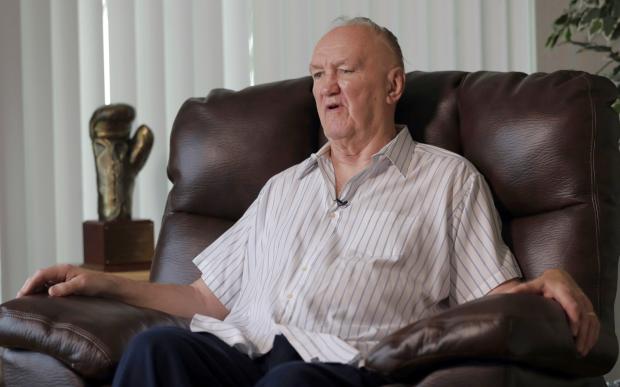
In this photo, taken April 26, 2017, former boxer Chuck Wepner talks to The Associated Press in his home in Bayonne, New Jersey. Forty-two years after he stepped into the ring against Muhammad Ali as a 40-to-1 underdog, Wepner’s business card still has a picture of the moment when he knocked down the champ. Wepner’s life story has now arrived on the big screen with Liev Schreiber playing the Bayonne Bleeder in “Chuck,” which opens on Friday, May 5, 2017, in New York and Los Angeles before expanding nationwide. (Photo by JULIO CORTEZ /AP)
BAYONNE, New Jersey — Forty-two years after he stepped into the ring against Muhammad Ali as a 40-to-1 underdog, Chuck Wepner’s business card still has a picture of the moment when he knocked down the champ.
For the New Jersey boxer, it gave him brief hope that he could win. For Ali, it led him to start fighting with a vengeance, eventually taking an exhausted Wepner out with 19 seconds left in the 15th and final round.
For Sylvester Stallone, the overmatched underdog’s fight was a moment of needed inspiration while writing the script for “Rocky.”
Stallone became a superstar and Rocky Balboa became an iconic character. Wepner reeled off a few more wins and continued his day job as a liquor salesman, while living a hard-partying lifestyle that led to prison.
Wepner’s life story has now arrived on the big screen with Liev Schreiber playing the Bayonne Bleeder in “Chuck, which opens on Friday in New York and Los Angeles before expanding nationwide starting next week.
“Everyone says to me, ‘Oh, Chuck, finally you got your due’,” the 78-year-old Wepner said from his living room in Bayonne, the working-class town across the harbor from New York where he grew up.
“You know what, I’ve been living large for 42 years. I fought Ali in ’75, I went 15 rounds, I had him down, and then they made the movie ‘Rocky.’ I was the inspiration. I haven’t been waiting around.”
Wepner and Balboa’s story share similarities – low-level working class fighters getting a shot at the champ. But while Rocky went on to beat the Ali-like Apollo Creed in their “Rocky II” rematch, Wepner turned to a life of partying and cocaine. He pleaded guilty to drug charges in 1987 and served two years of a 10-year sentence.
Like Rocky’s fight with Hulk Hogan’s Thunderlips character in “Rocky III,” Wepner was thrown out of the ring by wrestling legend Andre the Giant at Shea Stadium in New York in a 1976 fight. Unlike Rocky, Wepner also fought a bear.
Wepner sued Stallone in 2003, arguing that he improperly used his name to promote the “Rocky” films. Stallone responded that Wepner benefited by making public appearances as “the real Rocky,” but later settled. A spokeswoman for Stallone said he wasn’t giving interviews ahead of the film.
Schreiber said that it’s hard to look at some of the parallels between Rocky Balboa and Wepner and not think that Stallone was inspired by Wepner’s life.
“But I also know from talking to Sylvester Stallone that he thought the fighter was an amalgamation of several fighters,” Schreiber said, “and that probably the biggest inspiration to him was sort of his own battles as an artist, that was really the inspiration for the character.”
Schreiber, who said he was drawn to Wepner’s life as a cautionary tale of fame and celebrity, said that storytellers often exploit real people to create their narratives.
“And I think that’s OK,” he said. “I think that’s the nature of art and storytelling. Some stories stay very close to the truth … but I think we should also feel the license to expand on some things and express ourselves as fits the person that’s creating the story.”
“Chuck” also stars “Mad Men’s” Elisabeth Moss as Wepner’s second wife and Naomi Watts as his third wife, Linda. It was Linda who helped Wepner get his life together after he was released from prison and later convinced him to sue.
While Wepner admits he did a bad job auditioning after a night of partying when Stallone tried to give him a part as his sparring partner in “Rocky II,” the last straw was not being considered for a part in the Stallone and Robert De Niro film “Cop Land,” which filmed near Bayonne.
“I sued for $15 million, fuhgeddaboudit, I didn’t get a minute percentage of that,” Wepner said. “Stallone and I are friends now. We had to go to court. That was just business. I love Sylvester, I think he’s great. I think his moves are great.”
“Chuck” director Philippe Falardeau said that while there are similarities between Wepner and Rocky, Stallone’s character was “much more low-key, much more insecure. Chuck Wepner has no insecurities. He’s so confident.”
Falardeau said that Stallone gave the filmmakers his OK. Just as important, Falardeau says: As the movie ends with Schreiber’s Wepner and Watts’ Linda walking down the boardwalk, he stops for a Polaroid photo in front of a Rocky statue outside of a Planet Hollywood.
Falardeau said Stallone lent the statue to the filmmakers from his personal collection.